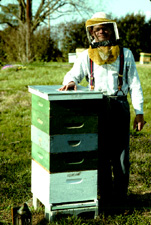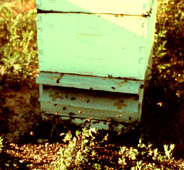Managing Bees for Pollination
- A Good Pollinating Hive
- Moving Hives
- Timing
- Number of Hives
- Hive Placement
- Chemical Attractants
- Bees and Pesticide
 If you need honey bees for pollination, you may want to keep your own bees. However, maintaining large numbers of robust hives year-round is hard work and most growers prefer to rent hives. For detailed information on managing bee hives, ask your Georgia county Extension agent or go to our site How to Get Started Keeping Bees. The section on Resources: Bees and Beekeeping Reference Books lists useful general texts.
If you need honey bees for pollination, you may want to keep your own bees. However, maintaining large numbers of robust hives year-round is hard work and most growers prefer to rent hives. For detailed information on managing bee hives, ask your Georgia county Extension agent or go to our site How to Get Started Keeping Bees. The section on Resources: Bees and Beekeeping Reference Books lists useful general texts.
Never expect a beekeeper to loan you colonies "in return for the honey they'll make." Moving bees is hard work, and almost no crop plants in Georgia yield surplus honey. Pollination is a valuable service that warrants fair compensation. See your county Extension agent for help in locating pollination services.
A Good Pollinating Hive
 A bee hive is made up of stacked boxes called supers. As colonies grow during a season, beekeepers add supers to accommodate the growing bee populations and honey stores. A very tall hive is probably strong, but don't rely on external appearances. When the lid is removed, bees should immediately "boil over" and blanket the tops of six to eight combs. In colonies with small populations, bees do not well up so dramatically. There should be at least five combs with brood. When brood is young, you can see glistening white larvae in their cells, but older brood are covered with cardboard-looking wax cappings. Bees are best motivated to collect pollen when they have young, uncapped brood. Strong colonies with large populations and plenty of brood are superior pollinators, and the beekeeper should get a higher rental fee.
A bee hive is made up of stacked boxes called supers. As colonies grow during a season, beekeepers add supers to accommodate the growing bee populations and honey stores. A very tall hive is probably strong, but don't rely on external appearances. When the lid is removed, bees should immediately "boil over" and blanket the tops of six to eight combs. In colonies with small populations, bees do not well up so dramatically. There should be at least five combs with brood. When brood is young, you can see glistening white larvae in their cells, but older brood are covered with cardboard-looking wax cappings. Bees are best motivated to collect pollen when they have young, uncapped brood. Strong colonies with large populations and plenty of brood are superior pollinators, and the beekeeper should get a higher rental fee.
Moving Hives
 Bee hives are almost always moved at night when bees are not flying and temperatures are cooler. Smaller beekeepers may screen hive entrances individually and manually load hives on and off a pickup truck. Larger beekeepers group hives, usually four to a pallet and load them with a forklift onto a trailer or flatbed truck; in these cases, the beekeeper may net the entire truckload to contain flying bees. In either case, be prepared for nighttime arrival and arrange details in advance with the beekeeper about field access and hive placement.
Bee hives are almost always moved at night when bees are not flying and temperatures are cooler. Smaller beekeepers may screen hive entrances individually and manually load hives on and off a pickup truck. Larger beekeepers group hives, usually four to a pallet and load them with a forklift onto a trailer or flatbed truck; in these cases, the beekeeper may net the entire truckload to contain flying bees. In either case, be prepared for nighttime arrival and arrange details in advance with the beekeeper about field access and hive placement.
Timing
Move hives into the crop after some flowering has already begun. If you move them in before the crop blooms, you give bees a chance to forage on another non-target plant such as Dutch clover. Once bees are trained to such competing flowers, they often ignore the crop when it blooms. Eliminate competing weeds with herbicides or mowing.
Number of Hives
The number of recommended hives per acre depends on the attractiveness of the crop to bees, number of wild bees, number of competing weeds, strength and location of bee hives, weather, and the grower's experience. Generally, anything that reduces pollination efficiency (unattractive crop, few wild bees, many competing weeds, poor weather, etc.) calls for more bee hives per acre to compensate. As a starting point, consider one hive per acre, and move up or down according to the advice of experienced growers, beekeepers, or your county Extension agent. The section on Crop Pollination Requirements gives more specific recommendations.
Hive Placement
Although honey bees can fly several miles, they prefer to work within 300 feet of their hive. For this reason, by putting groups of hives at 500-foot intervals (about 0.1 mile) within a field, you can place the whole field within ordinary bee foraging range. If the interior of a field is inaccessible, you can group hives around the edges. In these cases, the center of the field is less likely to be visited by bees, but you can remedy this by putting more colonies in the center-most groups along the field edge; this increases competition and forces bees to forage deeper into the field.
Place hives in ample sunlight and do not place them in low areas which accumulate cool, damp air. Chilly, shaded bees are poor pollinators. As much as possible, keep hives away from farm workers, pedestrians and livestock.
Chemical Attractants
Growers are sometimes interested in chemical attractants to increase the number of bees visiting their crops. The best of these products contain synthetic queen pheromone or components of Nasonov pheronome - a chemical bees use to orient to nest sites.
In general, attractants are helpful only under marginal pollination conditions. For example, it may be impossible for a beekeeper to unload hives in the center of a very large and muddy field. In this case, the grower may apply attractant to the center of the field to increase bee visitation. Remember, bee attractants encourage bee visitation, not necessarily bee pollination. If the flowers are not appealing to bees, no chemical attractant will make them work the blossoms. Likewise, if there are no bees in the area, an attractant will not draw them in from great distances. A grower's first priority must be the bees themselves.
Bees and Pesticides
 Most bee poisonings occur when bees visit flowers that were treated with insecticide. This kind of exposure is more hazardous than a direct spray on a hive. With fast-acting toxins, foraging bees are killed in the field. However, slower-acting toxins are even more hazardous to a colony because foraging bees survive long enough to return to the hive with contaminated pollen which enters the food supply and kills young bees for weeks. Such hives either die outright or become worthlessly weakened for the rest of the season.
Most bee poisonings occur when bees visit flowers that were treated with insecticide. This kind of exposure is more hazardous than a direct spray on a hive. With fast-acting toxins, foraging bees are killed in the field. However, slower-acting toxins are even more hazardous to a colony because foraging bees survive long enough to return to the hive with contaminated pollen which enters the food supply and kills young bees for weeks. Such hives either die outright or become worthlessly weakened for the rest of the season.
As a rule, never spray a plant that is flowering. However, many crop plants bloom in cycles which makes it difficult to use insecticides without risk to bees. Fortunately, there are still ways to reduce bee kill. First, not all insecticides are equally hazardous to bees. Some pesticides are listed below according to their relative bee hazard; look for a product labeled for the target pest, with low bee toxicity (that is, a high LD50), and with a short residual time (Table of Insecticides and Miticides). Secondly, granules and solutions are safer than wettable powders and dusts. Finally, many insecticides are deadly to bees when they are first applied but degrade within hours to a safer level. Since bees only forage in daylight, you can apply bee-hazardous pesticides in early evening. By morning the insecticide has controlled the target pests, but the residues are reduced and risk to bees is minimized.
Obviously, pesticide applications must be clearly worked out between the grower and the beekeeper. Most contracts require the grower to give the beekeeper a 24- to 48-hour notice of a pesticide application (see Sample beekeeper/grower contract). For more information, see Honey Bee Disorders.
